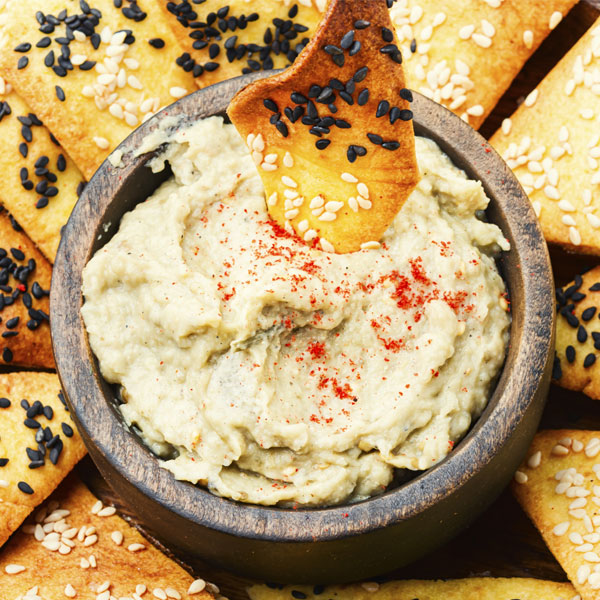The Largest Selection of Wholesale Mediterranean and Middle Eastern Products in Tampa
When it comes to trying new, exciting cuisine, few foods hit the spot like a deliciously fresh Mediterranean meal. However, we know that it can be very difficult to find authentic Mediterranean grocery wholesalers in Tampa, FL. Having lived in metro Atlanta for years, we realized that our customers needed an easy way to find quality wholesale Middle Eastern and Mediterranean food in bulk. That is why we created Nazareth Grocery Mediterranean Market - to give everyone a chance to enjoy tasty, healthy food, desserts, and authentic Mediterranean gifts at wholesale prices.
Founded in 2009, Nazareth Grocery has become one of Tampa's leading international wholesale grocery stores. We are very proud to serve our customers and do everything in our power to give them the largest selection of high-quality wholesale goods available.
If you're looking for the freshest, most delicious Middle Eastern wholesale products and ingredients, you will find them here at the best prices in the state. We encourage you to swing by our store in Marietta to see our selection for yourself. We think that you will be impressed!
The Nazareth Difference
At Nazareth Grocery Mediterranean Market, our mission is simple: bring you and your family the largest selection of wholesale Mediterranean products in Tampa. When coupled with our helpful, friendly staff and authentic Middle Eastern atmosphere, it's easy to see why we are the top Middle Eastern grocery wholesaler in Tampa, FL. We're proud to carry just about every kind of Mediterranean and Middle Eastern product that you can think of, from prepared meals and hookahs to fine seasonings and sweets. We're here for our customers and want each one of them to have a unique, one-of-a-kind experience when they shop with us.
Our loyal customers love our selection of the following wholesale foods and gifts:
 Fresh Breads
Fresh Breads Olives
Olives Hummus
Hummus Cheeses
Cheeses Sauces
Sauces Savory Foods
Savory Foods
 Desserts
Desserts Drinks
Drinks Hookahs
Hookahs Tobacco
Tobacco Gifts
Gifts Much More!
Much More!
- The Largest Selection of Wholesale Mediterranean
- The Nazareth Difference
- Most Popular Wholesale Mediterranean Foods
- Most Popular Wholesale Middle Eastern Foods
- Benefits of Eating a Mediterranean Diet
- Benefits of Eating a Mediterranean Diet Tips
- Why Buy Mediterranean and Middle Eastern Products Wholesale?
Our Service Areas
Most Popular Wholesale Mediterranean Foods
There is so much more to Mediterranean food than pizza and pasta. The perfect climate combined with delicious foods and amazing wine makes the Mediterranean incredibly irresistible. That's why our customers absolutely love to buy this kind of cuisine in bulk. Every country in this region has its own set of specialties and delicacies, each with its own flavors and styles of preparation.
Mediterranean countries include:
- France
- Greece
- Italy
- Turkey
- Syria
- Egypt
- Israel
- Libya
- Morocco
- Tunisia
- Spain

So, when it comes to the most popular wholesale Mediterranean products in Tampa,
what are we talking about?

Feta Cheese
Feta cheese is a classic Mediterranean dairy product that is often enjoyed on its own, in Greek salads, on bread, or mixed with zucchini. Depending on where the feta is sourced and produced, the cheese can be made from cow, sheep, or goat milk, or even a combination of the three. Regardless of the animal it comes from, this delicious cheese is a crowd favorite.

Baba Ganoush
This Levantine dish is one of the most well-known Mediterranean dishes to eat in the United States. It typically comes in the form of a dip, served with pita or another kind of dipping bread. Commonly served before dinner as an appetizer of sorts, it usually features tahini, eggplant, garlic, spices, and sometimes yogurt. This tasty cuisine works great as a spread on a sandwich, or you can even eat it with a spoon, all on its own.

Baklava
If you have never tried authentic baklava before, get ready to have your mind blown. This dessert is a traditional Mediterranean food that will have your taste buds craving more and more. Once you open a box of baklava from our Mediterranean grocery wholesaler in Tampa, FL, you won't want to stop eating! Baklava is made with layers of thin filo dough, which is layered together, filled with chopped nuts (think pistachios), and sealed with honey or syrup. Baklava is so good that its origins are debated, leaving many wondering which country invented the dessert. Everyone from the Turks to the Greeks and even Middle Easterners hold unique takes on baklava. Try each one to discover your favorite!
Most Popular Wholesale Middle Eastern Foods
Fresh, healthy, aromatic, rich: it's no wonder that the popularity of Middle Eastern cuisine and products has skyrocketed in the United States. This genre of cuisine features a large variety of foods, from Halvah to Labneh. If there were one common theme throughout all Middle Eastern food, it would be the bright, vibrant herbs and spices that are used. These flavorings help create rich, complex flavors that foodies fawn over. Typically, Middle Eastern food is piled high for all to eat, with enough food for an entire republic to put down.

Tabbouleh
This refreshing, healthy dish is chock-full of greens, herbs, tomatoes, and bulgur (or cracked wheat), creating a memorable, bold flavor. This dish may be eaten on its own or paired with a shawarma sandwich or helping of falafel. It's best to buy your ingredients in bulk to make this dish because it tastes best freshly made with family around to enjoy. Just be sure to bring a toothpick to the tabbouleh party - you're almost certain to have some leafy greens stuck in your teeth after eating.

Shawarma
We mentioned shawarma above, and for good reason - this dish is enjoyed by men and women around the world, and of course, right here in the U.S. Except for falafel, this might be the most popular Middle Eastern food item in history. Shawarma is kind of like a Greek gyro, with slow-roasted meat stuffed in laffa with veggies and sauce. The blend of spices and the smoky meat mix together to create a tangy, meaty flavor that you will want to keep eating for hours. For western-style shawarma, try using beef or chicken. For a more traditional meal, try using lamb from our Middle Eastern grocery distributor in Tampa, FL.

Hummus
Traditionally used as a dip meant for fresh pita, hummus is a combo of chickpeas, garlic, and tahini, blended together until silky, smooth, and creamy. You can find hummus in just about any appetizer section of a Middle Eastern restaurant menu. That's because it's considered a staple of Middle Eastern food that can be enjoyed by itself, as a spread, or with fresh-baked pita bread. Hummus is also very healthy, making it a no-brainer purchase from our grocery store.
Benefits of Eating a Mediterranean Diet
If there's one diet that is most well-known for its health benefits, it has got to be the Mediterranean diet. In 2019, U.S. News & World Report listed the Mediterranean diet as No. 1 on its best over diet list. This incredible diet has been cited to help with weight loss, brain health, heart health, diabetes prevention, and cancer prevention.
Whether you already love Mediterranean food or you're looking to make some positive changes in your life, this "diet" is for you. Eating cuisine like Greek food, Persian food, Turkish food, and Italian food is healthy and tastes great. Even better than that? At Nazareth Wholesale Grocery, we have many staples of the Mediterranean diet for sale in bulk so that you can stock up on your favorites at the best prices around.
So, what exactly is the Mediterranean diet?
It is a way of eating that incorporates traditional Greek, Italian, and other Mediterranean cultures' foods. These foods are often plant-based and make up the foundation of the diet, along with olive oil. Fish, seafood, dairy, and poultry are also included in moderation. Red meat and sweets are only eaten in moderation, not in abundance. Mediterranean food includes many forms of nuts, fruits, vegetables, fish, seeds, and more. Of course, you can find at them all at our wholesale Mediterranean grocery store!
Here are just a few of the many benefits of eating a healthy Mediterranean diet:

Reduced Risk
of Heart Disease
Many studies have been conducted on this diet, many of which report that Mediterranean food is excellent for your heart. Some of the most promising evidence comes from a randomized clinical trial published in 2013. For about five years, researchers followed 7,000 men and women around the country of Spain. These people had type 2 diabetes or were at a high risk for cardiovascular disease. Participants in the study who ate an unrestricted Mediterranean diet with nuts and extra-virgin olive oil were shown to have a 30% lower risk of heart events.

Reduced Risk
of Stroke for Women
In addition to the heart-healthy benefits of a Mediterranean diet, studies have shown that eating healthy Mediterranean and Middle Eastern foods can reduce the chances of stroke in women. The study was conducted in the U.K., which included women between the ages of 40 and 77. Women who stuck to the Mediterranean diet showed a lower risk of having a stroke - especially women who were at high risk of having one.
Benefits of Eating a Mediterranean Diet
First and foremost, purchase your Mediterranean and Middle Eastern wholesale foods from Nazareth Grocery - we're always updating our inventory! Getting started on this healthy, delicious diet is easy.
Try these tips:

1.
Instead of unhealthy sweets like candy and ice cream, try eating fresh fruit instead. It's refreshing, tasty, and often packed with great vitamins and nutrients.
2.
Try eating fish twice a week, in lieu of red meat. Fish is much healthier and doesn't have the unfortunate side effects of red meat, like inflammation.
3.
Try planning out your meals using beans, whole grains, and veggies. Don't start with meats and sweets.
4.
They're tasty, but try to avoid processed foods completely.
5.
Instead of using butter to flavor your food, use extra virgin olive oil instead. Olive oil contains healthy fats and tastes great too.
6.
Try to get more exercise and get out of the house. The Mediterranean lifestyle is an active one, best enjoyed in the beautiful sunshine when possible.
Why Buy Mediterranean and Middle Eastern Products Wholesale?
Buying wholesale and retail are quite different. When you buy products from a wholesaler, you're essentially buying from the middleman between a retail establishment and the manufacturer. Wholesale purchases are almost always made in bulk. Because of that, buyers pay a discounted price. That's great for normal buyers and great for business owners, who can sell those products to profit. This higher price is called the retail price, and it is what traditional customers pay when they enter a retail store.
Free Estimate
Latest News in Tampa, FL
Duclair of Lightning ready to face off against former team in 1st round
nhl.comhttps://www.nhl.com/news/lightning-anthony-duclair-facing-former-team-panthers
Forward looks forward to ‘a battle’ against Florida, where he played 3 seasonsTAMPA — Tampa Bay Lightning forward Anthony Duclair is familiar with the environment at Amerant Bank Arena during the Stanley Cup Playoffs. But instead of receiving cheers from the Florida Panthers fans, he’ll be on the other side for Game 1 of their Eastern Conference First Round series Sunday (12:30 p.m. ET; TV: ESPN, BS...
Forward looks forward to ‘a battle’ against Florida, where he played 3 seasons
TAMPA — Tampa Bay Lightning forward Anthony Duclair is familiar with the environment at Amerant Bank Arena during the Stanley Cup Playoffs. But instead of receiving cheers from the Florida Panthers fans, he’ll be on the other side for Game 1 of their Eastern Conference First Round series Sunday (12:30 p.m. ET; TV: ESPN, BSSUN, BSFL).
Duclair helped the Panthers reach the playoffs in each of the three seasons he was there and was an integral part of their run to the 2023 Stanley Cup Final. With Florida, he was on the losing end of two series against Tampa Bay and is ready to experience this rivalry from the other side.
“Obviously, it was a great three years there in Florida and I’ve got a lot of good memories,” Duclair said. “It’s going to be really special to play against these guys, especially in the first round. It’s going to be a battle.”
Duclair has given the Lightning a spark since he was acquired from the San Jose Sharks at the trade deadline. In 17 games, he has eight goals and seven assists while skating on the top line with Nikita Kucherov and Brayden Point.
His presence has allowed the Lightning to gain some continuity in their lineup which has led to a 12-4-2 record since Duclair was acquired.
“He’s a veteran and he’s another threat,” Lightning coach Jon Cooper said. “When you have another piece in the arsenal that can play anywhere in the lineup, that helps. When you can skate in this league, you have that burst and you can push defensemen back like ‘Dukie’ can, it’s an asset. He’s been great. He has fit right into our room.”
Anthony Duclair on joining the Lightning and Playoffs
Duclair said he’s been more than happy to offer his advice on what the Lightning need to do to have success against the Panthers for the third time in the past four years, but he also knows that both teams are very familiar with each other at this point.
“You look back to the last two series between these two teams and you know how tight-checked it was,” Duclair said. “There’s not going to be a lot of room out there. Good ol’ playoff hockey. It’s going to be fun.”
Panthers forward Matthew Tkachuk said there will be information shared on both sides.
“We do know some of his tendencies after playing with him, so we know his game a little bit,” Tkachuk said. “But he knows us as well. I am sure they are asking him about us. But they are a great team and he has been terrific since joining them. He is going to be a guy we need to keep an eye on and try and stop.”
Duclair had 99 points (43 goals, 56 assists) in 137 regular-season games with Florida. He reached career highs in goals (31), assists (27) and points (58) in the 2021-22 season.
He remains tied to the community in South Florida, where his efforts to make hockey more inclusive and grow the sport in the region led to the creation of the Anthony Duclair Foundation. Part of that initiative was realized in February when construction began on the first outdoor synthetic hockey rink located in Lauderdale Lakes, Florida.
“I just want to give back as much as I can,” Duclair said. “I’m looking forward to building more down the road. There are people down there I still connect with to this date and will continue to connect with in the future.”
Duclair also has plenty of friends in the Panthers locker room, but they don’t expect any communication with him for the next couple of weeks.
“He is obviously a great guy and a great friend to so many of us in here,” Panthers captain Aleksander Barkov said. “But, as he said on NHL Network, there are no friends on the ice — especially in the playoffs. It’s hockey, it’s business. Now we go against each other and he is just another player on that team.”
'Save Beer Can Island' effort offers a piece of paradise - for a price
Sarah Blazonishttps://baynews9.com/fl/tampa/news/2024/04/20/save-beer-can-island
APOLLO BEACH, Fla. — A Tampa Bay man is working to recruit people online to become part owners of Pine Key, a nine-acre island two miles off the shore of Apollo Beach. Current owners put it on the market for $14 million earlier this year.What You Need To Know “We wanted to see if we could get everybody together to do that and give people the opportunity to do...
APOLLO BEACH, Fla. — A Tampa Bay man is working to recruit people online to become part owners of Pine Key, a nine-acre island two miles off the shore of Apollo Beach. Current owners put it on the market for $14 million earlier this year.
What You Need To Know
“We wanted to see if we could get everybody together to do that and give people the opportunity to do that,” said Nicholas Lipidarov. “Maybe they wouldn’t be able to do that by themselves, but then together, we could all do it.”
Lipidarov set up a website asking people to “Help Save Beer Can Island” a few weeks ago. He’s asking for pledges of at least $1,000 that he said will be held in an escrow account in the trust of Pine Key Island, LLC, until the land is actually bought. He said that if the sale doesn’t happen, all the money would be returned. As of Friday night, 660 pledges had been made.
“The phone hasn’t stopped ringing all day long — phone, e-mail — and I’m just trying to keep up with everybody, but they are excited,” he said.
The current owners bought the island in 2017, and they said they’ve had their struggles with Hillsborough County, including a legal battle over code violation citations that were ultimately dismissed. Last year, commissioners talked about creating a new land use category for the island that owners worried might shut it down to the public. Lipidarov said he’s not worried about that.
“Of course, we’d always have to work with them to make sure that we’re doing everything as a family-oriented place, and I think they’d like to see that in the county,” he said.
Lipidarov said the goal is to keep the popular recreation a place the public can enjoy.
“We wanted to open it up to the public, and I think we have a lot of people on board that want to do that, as well. They want to make it accessible for everybody,” said Lipidarov.
The current owners have posted about Lipidarov’s effort on their own website. Co-owner Cole Weaver and Lipidarov said they had a meeting on Friday. Weaver said owners have several interested parties but aren’t under contract yet.
Lipidarov said if his effort is successful, he’d like to make the island even more family friendly, expand the beach, and build breakwaters, among other additions. He said the deadline to submit payments will be sometime at the end of May.
Satisfy your munchies with these 4/20 restaurant deals
Sara Filipshttps://www.wfla.com/dont-miss/satisfy-your-munchies-with-these-4-20-restaurant-deals/
TAMPA, Fla. (WFLA) — If you’re looking to satisfy your munchies on marijuana’s unofficial holiday — 4/20 — these restaurants are rolling out freebies and discounts to help you get through the day. Florida bill would blunt recreational marijuana potency if ballot measure passes Jimmy John’s $10 &lsquo...
TAMPA, Fla. (WFLA) — If you’re looking to satisfy your munchies on marijuana’s unofficial holiday — 4/20 — these restaurants are rolling out freebies and discounts to help you get through the day.
Jimmy John’s $10 ‘Dime Bag’
Got the munchies? Jimmy John’s has you covered. The “freaky fast” sub restaurant is offering a “Deliciously Dope Dime Bag” for $10 on Saturday. The bag comes with everything someone needs to celebrate 4/20, including a hand-sliced smoked ham and provolone cheese sandwich, alongside a pickle spear, a fudge chocolate brownie and a serving of Jimmy Chips.
Popeye’s Louisiana Chicken ‘Munchie Menu’
Mind on the “Popeyes Munchies Menu”?
“No, you’re not trippin’,” the chicken joint wrote in a post announcing its Munchies Menu with a chicken sandwich for $4.20 through Saturday. The specialty menu also features Coca-Cola, mashed potatoes with Cajun gravy, Cajun fries, and mac & cheese.
Mellow Mushroom’s $4.20 deal
Are we surprised that Mellow Mushroom is offering a 4/20? Like every year, the groovy pizzeria is selling its signature pretzel bites for $4.20, online order only with the code MEL420.
Smashburger: 4 for $20 deal
On Saturday, you can get four Classic singles for only $20. The discount will automatically be applied at checkout when you order online or in the app. Those who dine in can mention the offer to the cashier at check out.
Hotbox with Wingstop
Ready to hotbox on 4/20? Wingstop is bringing back its “Hot Box” with your choice of their chicken sandwich, 8-piece classic or boneless wings, or 3-piece tenders, in a new T.H.C. (The Hot Chili) Rub, seasoned fries, and a 20 oz. drink.
The deal lasts until April 21, through the Wingstop website or the Wingstop app, while supplies last.
Did we miss any? If you know of any Tampa Bay area restaurants with deals this Saturday, email WFLA at [email protected].
2024 Stanley Cup Playoff Preview: Panthers vs. Lightning
Sportsnet.cahttps://www.sportsnet.ca/nhl/article/2024-stanley-cup-playoff-preview-panthers-vs-lightning/
It’s a great time to be a hockey fan in Florida.Not only does the first-round series between the Florida Panthers and Tampa Bay Lightning offer a pretty friendly commute, it also promises to pack a punch — when these...
It’s a great time to be a hockey fan in Florida.
Not only does the first-round series between the Florida Panthers and Tampa Bay Lightning offer a pretty friendly commute, it also promises to pack a punch — when these rivals meet nowadays, it always does.
These clubs first clashed in the playoffs in 2021 with a fast, fun series that saw the defending champions best the Panthers in six and leave hockey fans everywhere clamouring for a seventh. The Lightning went on to win the Cup that year for the second straight season — but not without a few black-and-blue souvenirs from their Floridian foes to kick off the title defence.
The two sides met again in Round 2 a year later, though Tampa Bay swiftly solved Florida in four. Now, as they prepare for a third post-season meeting, there’s been a notable power shift between these two clubs. After three straight trips to the Cup Final and two rings to show for it, the Lightning were ousted from Round 1 by Toronto last spring while the Panthers made a thrilling run all the way to the Stanley Cup Final. That Cinderella run was no fluke — one year later, they’ve overcome season-opening injuries to major stars and fought their way to the top of the Atlantic Division thanks to a roster with no shortage of depth and a goalie who’s rediscovered his game.
There are plenty of similarities between these two clubs, from the steady scoring threat up and down the lineup to the staunch blue line that’s come up clutch offensively, too. Goaltending is a source of strength at both ends, and with two of the most thoughtful, respected head coaches patrolling either bench, we’re all set for some insightful post-game quotes, too.
Long viewed as the Lightning’s kid brother, the Panthers hold the upper hand now, despite going 0-2 in series matchups against Tampa Bay.
Watch the Stanley Cup Playoffs on Sportsnet It all comes down to this: 16 teams, one trophy. Watch every game of the Stanley Cup Playoffs live on Sportsnet+, beginning on April 20.
Panthers Outlook: The post-season is a marathon, but for last year’s Florida Panthers it was an all-out sprint from start to finish, their Cinderella run from last-minute WC2 to Stanley Cup runners-up a thrilling display of grit and momentum best captured by the fearless Matthew Tkachuk.
After watching that unfold, it should surprise no one to see Florida atop the division (thanks in part to a little last-minute sprint, of course; they’re nothing if not on-brand) a year later, ready to build on last year’s incredible streak. And yet, it is a bit surprising, considering what they’ve overcome to get back to the post-season. The club opened the 2023-24 campaign short-handed as star defencemen Aaron Ekblad and Brandon Montour required extra recovery time after summer surgeries. Ekblad was forced to miss more time late in the season, with Oliver Ekman-Larsson and Carter Verhaeghe also banged up down the stretch. (Verhaeghe returned Tuesday and all three look good for Game 1.)
Despite already boasting one of the deepest rosters in the league, Florida brought in veteran sniper Vladimir Tarasenko, who’s looked great on the top line alongside assist specialist Aleksander Barkov and scoring leader Sam Reinhart, whose 57 goals on the season is second league-wide to only Auston Matthews’ 69.
Health, or a lack of it, is most likely the only thing that can take down this blue line, which also includes a revitalized Ekman-Larsson having his best season since his days starring in the desert. “Revitalized” is a word that best describes goaltender Sergei Bobrovsky, too — the starter was excellent last post-season and has built on that momentum all year as he gears up for another.
Lightning Outlook: There’s a reason the Lightning are back in the post-season for a sixth straight year, and his name is Nikita Kucherov. In a season that has so thoroughly spoiled hockey fans as the game’s biggest names have piled up points at historic rates, Kucherov’s MVP bid is a strong one. He leads his team in scoring by a whopping 54 points, and his 100 assists on the season (37 more than Victor Hedman’s second-ranked team total) put him in the history books.
Kucherov, now the proud owner of several franchise records, has factored into half of all Lightning goals this season.
The story of Kucherov’s season has shielded the team from showing some signs of slowing down. A season-ending injury to Mikhail Sergachev was a huge blow for the squad’s blue line, while franchise netminder Andrei Vasilevskiy has looked mortal at times. Talk of Steven Stamkos’ future with the club will only grow louder as he barrels towards free agency. This post-season has the makings of a franchise-altering spring as we await what’s next for the former champs. Do they have another fight in them?
ADVANCED STATS
(5-on-5 totals via Natural Stat Trick)
REGULAR SEASON TEAM STATS
Panthers X-Factor: What can you improve on a team that’s got everything? Yup, it’s special teams. While neither their power play nor penalty kill have presented major problem areas this year, a closer look reveals some recent struggles. Since March 1, Florida has scored on just 16.4 per cent of power-play opportunities — a far cry from Tampa Bay’s 27.4 per cent in that same time frame.
Against the Lightning’s top-rated penalty kill since March 1, that weakness could prove the difference between a first-round win and an early loss.
Stanley Cup Playoffs Round 1: Panthers vs. Lightning Keep up with the latest news and analysis as the Florida Panthers face the Tampa Bay Lightning in a clash of state rivals during Round 1 of the Stanley Cup Playoffs.
Lightning X-Factor: Bobrovsky taught opponents some valuable lessons last spring about what happens when a team runs into a hot goalie in the playoffs … but Vasilevskiy wrote the book.
But this season has brought some uncharacteristic performances for the netminder, whose goals-against average (2.90) and save percentage (.900) in 52 starts were both career lows. The 2021 Conn Smythe winner has a knack for shutting the door in series-clinching games, and should he regain that form against Florida, there’s no telling how far the Lightning might go.
POSSIBLE GAME 1 LINEUPS
Florida Panthers
Vladimir Tarasenko-Aleksander Barkov-Sam ReinhartCarter Verhaeghe-Sam Bennett-Matthew TkachukEetu Luostarinen-Anton Lundell-Evan RodriguesNick Cousins-Kevin Stenlund-Kyle Okposo
Gustav Forsling-Aaron EkbladNiko Mikkola-Brandon MontourOliver Ekman-Larsson-Dmitry Kulikov
Sergei BobrovskyAnthony Stolarz
Tampa Bay Lightning
Anthony Duclair-Brayden Point-Nikita KucherovBrandon Hagel-Anthony Cirelli-Steven StamkosMichael Eyssimont-Nick Paul-Mitchell ChaffeeTanner Jeannot-Luke Glendening-Conor Sheary
Victory Hedman-Darren RaddyshNick Perbix-Erik CernakHaydn Fleury-Matt Dumba
Andrei Vasilevskiy Jonas Johansson
Exciting venues come to Water Street Tampa: Alter Ego and Ash
Brody Wooddellhttps://www.wfla.com/bloom-tampa-bay/bloom-living-local/two-exciting-venues-come-to-tampa-alter-ego-and-ash/
TAMPA, Fla. — The nightlife and dining scenes in Tampa just got more exciting with the opening of two new venues by Proper House Group: Alter Ego and Ash. Both establishments are located in the bustling Water Street Tampa district and promise to offer unique experiences to their patrons.Alter Ego: A New Nightlife ExperienceAlter Ego, opened on April 19, 2024, is set to redefine Tampa’s nightlife with its...
TAMPA, Fla. — The nightlife and dining scenes in Tampa just got more exciting with the opening of two new venues by Proper House Group: Alter Ego and Ash. Both establishments are located in the bustling Water Street Tampa district and promise to offer unique experiences to their patrons.
Alter Ego: A New Nightlife Experience
Alter Ego, opened on April 19, 2024, is set to redefine Tampa’s nightlife with its music-forward cocktail lounge concept. The venue blends top-tier DJs, inventive mixology, and soulful hospitality. According to Ty Rodriguez, one of the PHG partners, Alter Ego is designed to be a monochromatic and moody space that offers an intimate and immersive music experience. “We’re giving guests the chance to interact with the music in an unparalleled, sexy atmosphere,” Rodriguez explained.
The lounge’s design, a collaboration with Gin Design Group, features sleek, backlit architectural forms against luxurious upholstery, creating an inviting yet provocative environment. Music Director Justin Layman, also known as “DJ Casper,” is set to bring in some of the nation’s most sought-after DJs. The opening lineup includes DJ Epik, Angelica Rose, Rich Medina, and Spreadsheets, with more to be announced.
Ash: Italian Flair Meets Modern Ambiance
Just steps away, Ash also celebrated its grand opening on the same day, bringing a fresh Italian-inspired dining concept to Tampa. Led by Chef Ferrell Alvarez, Ash promises a playful yet sophisticated dining experience. The restaurant’s atmosphere is enhanced by custom furnishings, arched lighting, and textural touch points throughout its open kitchen and dining areas.
The menu at Ash is all about bold, unconventional flavors. Highlights include Binchotan grilled Corbacci peppers, house-made Malfade pasta with Dungeness crab, and a 22-ounce Sakura pork chop ‘Milanese.’ Beverage Director Jon Howard oversees a bar program that features a robust selection of Italian-forward cocktails.
Community and Quality
Both venues underscore Proper House Group’s commitment to innovation and excellence in the Tampa Bay area. The group, known for its range of acclaimed dining venues like Rooster & the Till, has become a significant player in the local culinary scene. Josh Taube, CEO of SPP, expressed excitement about the expansion, stating that both Alter Ego and Ash build on PHG’s ongoing achievements and add a unique flavor to the district.
Whether looking for an electrifying night out or a sophisticated dinner, Tampa residents and visitors can now enjoy these latest offerings from Proper House Group. Reservations are recommended for both venues, with Alter Ego open Sunday to Wednesday until midnight and extended hours on weekends, and Ash operating from Tuesday to Sunday, with plans to open daily this summer.
For more details or to make a reservation, visit www.alteregotampa.com and www.ashtampa.com.
Follow me for more like this including reviews!
Disclaimer:


 770-795-9026
770-795-9026


